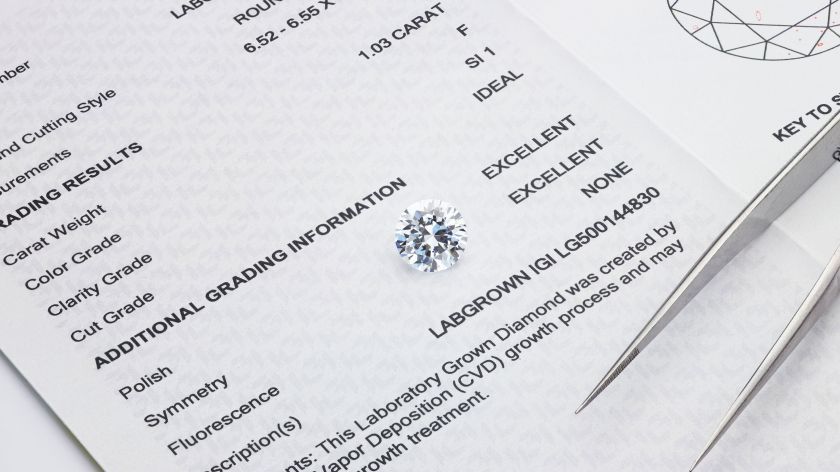What are the 4 C’s of Diamonds and What Do They Mean?
CARAT
It’s not a vegetable… The metric carat, which equals 0.20 gram, is the standard unit of weight for diamonds and most other gems. To simplify this further, it’s the size of the diamond when it’s loose, meaning not in the mounting. If other factors are equal, the more a stone weighs, the more valuable it will be. How many carats do I want? In the trade, diamond prices are expressed as a price per carat. The “Carat Weight” has the biggest impact on the price of a diamond. For example, a 2 carat diamond is more than double the price of a 1 carat diamond. To put it bluntly, SIZE DOES MATTER but it’s less important than the quality of the diamond. Consumers tend to prefer larger carat weights because they may carry more status. However, larger carat weight does not alone signify a better ring. Note: When you see "T.W.", or "Total Weight", it will refer to the total carat weight, per gem type (descriptions are usually broken down by gem-type). So a ring with emeralds and sapphires and diamonds could say: Emerald t.w. = 0.25 cts., Sapphires t.w. = 0.31 cts., Diamonds t.w. = 0.75 cts. This refers only to the weight as measured when the gems are loose and unmounted. It has nothing to do with the number of gems contained in the Jewelry. The above example could mean there were 5 emeralds, 7 sapphires and 50 diamonds as easily as it could mean that there were 2 emeralds, 2 sapphires and 2 diamonds.
COLOR
If you’ve thought that diamonds are colorless, you may be surprised to learn that most diamonds have at least a trace of yellow or brown color.
Note that the color of a diamond has the second biggest impact on its price, after carat weight.
Grading "colorless" diamonds actually involves deciding how closely a stone approaches colorlessness. The reason colorlessness is most highly valued is that diamonds in these ranges act like prisms, separating white light passing through them into a wide spectrum of colors. The more transparent the diamond, the wider the spectrum of colors. Colorless diamonds tend to be more valuable.
Rare colors such as blue, pink, purple, or red also tend to be very expensive—and very beautiful—and are known as “fancy color” diamonds.
If a diamond does not have enough color to be called fancy, then it is graded in a scale of colors ranging from Colorless to Light Yellow, "D" through "Z". A diamond with a "D" color is considered to be colorless. If the color is more intense than "Z", it is considered fancy.
CLARITY
Are we expressing this clearly?
“Clarity” describes the absence or presence of internal and external flaws. A perfect stone with perfect clarity (clearness) is rare, although some flaws cannot be seen without using a loupe for magnification.
Just like eggs, diamonds come in grades!
Diamond Grades:
FL - Flawless
These stones have no imperfections inside or on the outside of the stone under the magnification of a loupe of 10X magnification.IF - Internally Flawless
This grade is awarded to diamonds with no internal flaws and only minor external blemishes.VVS1, VVS2
Very Very Slightly Imperfect—These stones have very, very small inclusions, which are extremely difficult to see under a loupe of 10X magnification.VS1, VS2
Very Slightly Imperfect—These stones have very small inclusions, or imperfections, which are slightly difficult to see under a loupe of 10X magnification.SI1,SI2
Slightly Imperfect—These stones have inclusions, which are fairly easy to see with a 10X magnification, and can be seen with the naked eye.I1, I2, and I3
Imperfect—These stones have inclusions ranging from moderately visible to very easily seen to the naked eye.
CUT
The word “cut” doesn’t refer to the shape of the diamond (when has trade jargon ever been clear and simple?). Rather, cut means the way the diamond was faceted to allow light to reflect from it. In a well-cut diamond, light enters the diamond and reflects straight back to the viewer's eye. Some cutters will sacrifice cut to create the largest possible diamond, thus making too shallow or too deep of a cut and not allowing light to reflect as well as it might.
The width and depth can have an effect on how light travels within the diamond, and how it exits in the form of brilliance.
Too Shallow:
Light is lost out the bottom causing the diamond to lose brilliance.Too Deep:
Light escapes out the sides causing the diamond to appear dark and dull.
Polish and symmetry are two important aspects of the cutting process. The ‘polish’ grade describes the smoothness of the diamond's facets, and the ‘symmetry’ grade refers to alignment of the facets.
For the most beautiful diamond, look for a symmetry grade of excellent (EX), very good (VG), or good (G). Avoid diamonds with symmetry grades of fair (F) or poor (P).
If you still need help or have any questions regarding diamond buying, please email: buyer@louped.com and we will be happy to assist you.









